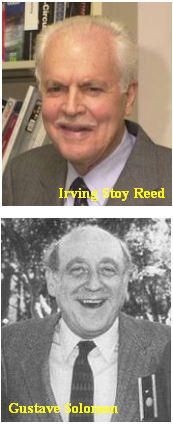Difference between revisions of "Aufgaben:Exercise 2.10Z: Code Rate and Minimum Distance"
| Line 23: | Line 23: | ||
Hints: | Hints: | ||
| − | * The exercise belongs to the chapter [[Channel_Coding/Definition_and_Properties_of_Reed-Solomon_Codes| "Definition and | + | * The exercise belongs to the chapter [[Channel_Coding/Definition_and_Properties_of_Reed-Solomon_Codes| "Definition and Properties of Reed–Solomon Codes"]]. |
* Information relevant to this exercise can be found on the [[Channel_Coding/Definition_and_Properties_of_Reed-Solomon_Codes#Code_name_and_code_rate|"Code name and code rate"]] page. | * Information relevant to this exercise can be found on the [[Channel_Coding/Definition_and_Properties_of_Reed-Solomon_Codes#Code_name_and_code_rate|"Code name and code rate"]] page. | ||
Revision as of 11:03, 12 October 2022
The codes developed by Irving Stoy Reed and Gustave Solomon in the early 1960s are referred to in this tutorial as follows:
- $${\rm RSC} \, (n, \, k, \, d_{\rm min}) _q.$$
The code parameters have the following meanings:
- $q = 2^m$ is an indication of the "size" of the Galois field ⇒ ${\rm GF}(q)$,
- $n = q - 1$ is the "code length" $($symbol number of a code word$)$,
- $k$ indicates the "dimension" $($symbol number of an information block$)$,
- $d_{\rm min}$ denotes the "minimum distance" between two codewords.
- For any Reed-Solomon code:
- $$d_{\rm min} = n - k + 1.$$
No other code with the same $k$ and $n$ yields a larger value.
Hints:
- The exercise belongs to the chapter "Definition and Properties of Reed–Solomon Codes".
- Information relevant to this exercise can be found on the "Code name and code rate" page.
Questions
Solution
- The code rate is given by $R = {223}/{255} \hspace{0.15cm}\underline {=0.8745}\hspace{0.05cm}.$
- The minimum distance is $d_{\rm min} = n - k +1 = 255 - 223 +1 \hspace{0.15cm}\underline {=33}\hspace{0.05cm}.$
- This allows
- $e = d_{\rm min} - 1 \ \underline{= 32}$ symbol errors can be detected, and.
- $t = e/2$ (rounded down), so $\underline{t = 16}$ symbol errors can be corrected.
(2) The code $\rm RSC \, (2040, \, 1784, \, d_{\rm min})_2$ is the binary representation of the ${\rm RSC} discussed in (1) \, (255, \, 223, \, 33)_{256}$ with exactly the same code rate $R \ \underline{= 0.8745}$ and also the same minimum distance $d_{\rm min} \ \underline{= 33}$ as this one. Here $8$ bits (1 byte) are used per code symbol.
(3) From $d_{\rm min} = 33$ follows again $t = 16 \ \Rightarrow \ N_{3} \ \underline{= 16}$.
- If exactly one bit is corrupted in each code symbol, this also means 16 symbol errors.
- This is the maximum value that the Reed–Solomon decoder can still handle.
(4) The RS decoder can correct 16 corrupted code symbols,
- whereby it does not matter whether in a code symbol only one bit or all $m = 8$ bits have been corrupted.
- Therefore, with the most favorable error distribution, up to $N_4 = 8 \cdot 16 \ \underline{= 128}$ bits can be corrupted without the code word being incorrectly decoded.
